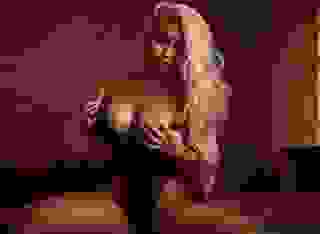- Romance
- Hot-Wired Juana
Note: You can change font size, font face, and turn on dark mode by clicking the "A" icon tab in the Story Info Box.
You can temporarily switch back to a Classic Literotica® experience during our ongoing public Beta testing. Please consider leaving feedback on issues you experience or suggest improvements.
Click hereAccording to his report, the patrol officer had followed the black Land Rover SUV when it had passed him going south on Rivergate Parkway because it looked to him like the front side windows were tinted darker than Tennessee state law allows. He thought that because he couldn't see the driver through the window. Some people have their windows tinted pretty dark to keep the summer sun from cooking everything inside the car, but more often than not, it's done because the driver doesn't want to be seen. Really dark windows are common on cars used by drug dealers and that's what made Bobby interested in the SUV.
He followed the SUV for a few blocks and watched for anything that looked like the driver was under the influence or was really nervous at being followed by a police car. He also ran the license number of the SUV through the state DMV records. The SUV was registered to Mende Imports, and Bobby recognized that name.
That name gave Bobby a reason for stopping the SUV besides the window tint. Mende Imports was owned by Carlos Menendez, and Menendez was suspected of being the head of the Mexican cartel operating in Nashville. That cartel controlled the trade in illicit drugs and human trafficking among other things. Both the Nashville PD and the TBI had been watching Menendez for years and were certain of his status, but hadn't been able to prove it. The reason was although we knew his name and where he lived, he'd never been seen.
The house was a veritable mansion sitting in the center of about a hundred acres on a point on Percy Priest Lake. The property was fenced down to within thirty feet of the water line with wrought iron fencing ten feet high, and there was more wrought iron fencing from there down to the boat house and dock on the lake. Aerial photos showed that in addition to the wrought iron fencing and massive wrought iron gate enclosed the entire property, there was another wrought iron fence and another gate around the house proper. There was a stable and a few outbuildings on the property as well.
The purchase price of the land was somewhere in the neighborhood of two million based upon the prices of lakefront property at the time the property was purchased by Mende Imports. It was difficult to get an accurate cost for the house and other improvements since no one contractor managed the construction. Instead, a representative of Mende Imports hired and managed all the subcontractors. The estimate based on the building permits issued to Mende Imports was at least ten million for the house and another five million for the fences and outbuildings.
The purchase of the land and construction of the house had triggered an investigation by the TBI. It wasn't that lavish homes were odd around Nashville because they weren't. Nashville has several financial institutions that pay their top people enough to afford a home like that, and the music industry can create a millionaire almost overnight. What triggered the TBI is there was no financial institution holding a mortgage on anything. Mende Imports had paid for everything with checks from a bank in the Cayman Islands. Since there was little information about what Mende Imports did, the TBI suspected organized crime was involved.
The TBI became even more suspicious when they ran a weeklong surveillance on the property.
The main gate was always manned by at least one armed guard, but that guard wasn't an employee of any of the security guard companies in Nashville. None of them were seen leaving the property either, and that reinforced the TBI's theory that Mende Imports was a front for illegal activities. The only people regularly coming and going from the property appeared to be domestic staff and a lawn care service that changed every month.
None of what had been observed during the surveillance was illegal, so asking a judge for a warrant for the finances of Mende Imports or a phone tap wouldn't go anywhere. Whoever lived in the house could have just been some rich guy who didn't like people.
Anyway, when Bobby saw who owned the SUV, he thought maybe he'd gotten lucky. When the car made it only half way through the next intersection before the light switched to red, he flipped on his lights.
The driver, one Juana Marie Pena, had done everything she should have. She had both hands on the steering wheel when Bobby walked up to the driver's side window. She rolled down the window when he asked, and when he asked for her license, registration, and proof of insurance, she said she'd have to get them from her purse and from the glove box. Bobby followed her hands as she did, and then took the license back to his cruiser.
According to her license, Juana was twenty-one, had dark brown hair, brown eyes, was five three, and weighed one hundred pounds. All that matched the woman in the car, but Bobby ran her license anyway.
Miss Pena's license came back clean, and her insurance certificate was current. Bobby didn't have anything that would allow him to search the car or bring her back to the station, but he did ask her why she was driving a car that wasn't registered to her. Her reply made sense.
"I cook for Mister Menendez so I also buy the groceries. He lets me use this car because I don't have one."
Bobby gave her a warning ticket for running the stoplight because the light had been yellow when she started through the intersection and because she had cooperated with him. When he checked the window tint, it was legal, but barely, so he didn't write a ticket for that. He told her to be safe and let her go.
Bobby was entering the information from the warning ticket into his laptop when the SUV drove away. As it happened, traffic was fairly light after Riverside Parkway changed from four lanes to the two lanes of Myatt Drive, and Bobby caught up with the SUV sitting at a stoplight a few minutes later. He was three cars behind the SUV and when the light changed, the SUV turned left onto Spring Branch Drive.
Bobby thought that odd. Spring Branch Drive led to the Shepherd Hills area, and Shepherd Hills was not a place most people who didn't live there would ever go, much less a woman in an expensive SUV. In Shepherd Hills, any display of wealth was likely to get you added to the already high crime statistics for the area. The only likely reason for someone with money to drive to Shepherd Hills was drugs. When the Nashville PD investigated a crime in Shepherd Hills, it was usual to find drugs involved in some way and they'd made several busts of low-level dealers who sold to the people from other parts of Nashville.
Bobby had no reason to follow the SUV, so he didn't, but he did add that detail to his report. The SUV's owner was why a copy of his report landed in my inbox a couple days later. I'm Bill Jameson, a TBI investigator working on a drug taskforce with the Nashville PD.
The report wasn't what they always say on cop shows on TV. It didn't "break the case wide open". It was, however, more information. The information that interested me most was the fact that an SUV owned by Mende Imports had driven into Shepherd Hills.
We'd tailed a few vehicles that left the compound and they always went to one of the Hispanic areas of Nashville. Some went to Hispanic run grocery stores. Some went to Hispanic run auto shops. We'd investigated all those places and had found them to be legitimate businesses with no hint of drugs or any other illegal activities going on. This was the first time we'd seen anything that offered a possible connection between Menendez and the drug traffic.
I didn't understand why he'd send a woman to take care of business in Shepherd Hills, but it actually just showed how smart Menendez was. A woman wouldn't attract attention by anybody. Anyone seeing Juana driving an expensive SUV would just figure she was one of the many well to do in Nashville. The residents around Shepherd Hills might raise an eyebrow or two if they saw her drive into the area, but seeing nice cars going there was a fairly common occurrence because drugs seemed to go hand in hand with some people in the music business.
I looked at Bobby's report and after writing down what I thought might be useful, I filed it with the thousand or so other reports in the Menendez file. I didn't forget about it though. If that woman in that SUV had been doing what it looked like, it probably wasn't the first time and it probably wouldn't be the last.
I looked up the license number and found out the SUV had been registered in Tennessee in 2019, a little less than a year. The VIN number told me the SUV was a 2018 model, so unless it had sat on a dealer's lot for a year before that, it had to have come from somewhere else.
When I keyed the VIN number into the database we use to track vehicle history, the answer that came back made me even more suspicious. The SUV had been sold and licensed in El Paso, Texas to one Jose Cano. I also found out that while registered in Texas, the SUV had been stopped going across the border from Mexico to El Paso because one of the drug dogs alerted on it.
The vehicle had been stripped down and five kilos of cocaine was found inside. The vehicle was then confiscated and later sold at auction to one Herve Mendoza. Mendoza had then sold the SUV to Mende Imports.
The thing that stunk about that was that when DEA takes a car apart, it's really hard to put it back together so it looks like it did before the search. Drug smugglers are very good at hiding where they put their drugs. The only way to find them is to look for things that don't look original and then take those things apart. Often that means the carpets get ripped out, seats get cut open, and the dashboard gets taken out. Most of those vehicles are sold for parts at auction. The buyer salvages what parts he can and sends the rest to a recycling yard.
I called Bobby and asked him what condition the SUV was in when he stopped it. His answer was interesting.
"Well, I didn't look all that close because I was watching the woman, but it looked almost brand new to me. One thing that did stick out was the sticker on the windshield. It was from one of those companies that will replace your windshield right in your driveway. I figured the windshield got cracked and the owner had it replaced."
That gave me a possible explanation for why the SUV looked new. Early in my career, I'd been assigned to another task force working on car theft. What we eventually found out was the guys were stealing cars and then replacing the VIN tags on the dash with the VIN tags from wrecked cars of the same make and model. It's easy enough to do if you take out the windshield and have the same tool the manufacturers use to put in the VIN tag. The VIN number can also be found in other places like on a tag on the driver's side door and on the engine block, but the tag on the dash is where most people, including police officers, would look.
It was likely the SUV had been stolen and re-tagged with the VIN number from the Texas car. The only way to know for certain would be to find the SUV and check the VIN number on the dash with the VIN numbers in the other possible locations. For the time being, that was a dead end. We could find the SUV, but unless we had what the law calls "a reasonable suspicion", we couldn't search the car without a warrant or permission of the driver.
That term, "reasonable suspicion" is pretty broad, but can be difficult to defend in court. Just because Bobby had seen the SUV going in the direction of Shepherd Hills wouldn't be reasonable suspicion of any involvement in drugs.
One thing I had learned about the drug trade is while the street dealers may not be the sharpest people on the planet, the top guys didn't get where they are without being pretty smart. Menendez had enough money to buy multiple new Land Rover SUV's. Unless he had a very good reason, he wouldn't have bought a used vehicle and I was sure he'd have checked the history to make sure it wasn't stolen.
It was a week later that a street dealer named "Tez" turned up dead beside a dumpster behind a bar in Shepherd Hills. He was dead because he had two.22 caliber bullet holes in the back of his head, the classic execution style killing meant to send a message.
As often is the case with drug related murders, the Nashville PD asked the TBI for assistance, and the assistance the TBI sent was me.
The Nashville PD had done a good job of investigating, but hadn't found much evidence that led anywhere. They knew the scene of the murder was where the guy was found, but they found no shell casings and no prints on anything in the general area. That and how Tez was shot were the marks of a professional hit. Tez had pissed off somebody enough they decided they were better off taking him out of the picture.
The coroner had estimated time of death at between 11:00 PM and 4:00 AM the next morning. The Nashville PD had talked to the bartender and several people who lived on the upper floors over the businesses in the area, but none had heard any shots fired during that time.
The Nashville PD had also looked for any security cameras that might have seen anyone going in or out of the alley on the night of the murder. They'd found four and had the video from all of them from the afternoon of the murder to the next morning.
The camera on the pawnshop across the street from the bar had taken video at 12:07 of one guy exiting the alley. Unfortunately, like most security camera video, this one was pretty fuzzy and since it was dark the only relatively clear view of the guy was for about two seconds when he walked under a street light. Even then, it was hard to tell anything about him because he was wearing a ball cap and had his head down.
I got a copy of all four videos and took them back to my office to see if the techs could enhance the video quality. Sometimes that works. In this case, it didn't. I was left with a little clearer image of the guy coming out of the alley, but still not enough for a positive identification.
Something that seemed unusual was there was no video of the guy going into the alley. That could mean he went in the alley earlier, but I couldn't find any evidence of that. I'd watched the video from 4:00 that afternoon, and the only thing that went into that alley was a stray cat. The guy had to have gone in the alley from somewhere else.
I thought maybe it was from the other end, so I drove over to the scene to see if there was a security camera at the other end of the alley. I found one on a drug store that had a view of the street on north side of the alley and another that had a view of the street on south side of the alley. When I watched both videos for the same time period, there were people walking past but nobody went down the alley. I'd see them on one video and a couple seconds later, the same person would show up on the other.
I got copies of both and took them back to my office, and once I got there, I watched them on a bigger screen. I was concentrating on the alley so hard, I almost missed the black SUV that drove past on both cameras. When I rewound the video and then stopped it, that black SUV looked a lot like a Land Rover.
I put the DVD with the video from the camera in front of the bar in the disc drive and fast-forwarded it to 11:45, the time the SUV had driven past the other two cameras. At 11:46, the black SUV had parked on the street across from the bar and a short man wearing a ball cap got out and walked into the bar. I still couldn't make out his face because he had his head down.
I then fast-forwarded that video to 12:01 AM and watched the next ten minutes. At 12:08, the same guy walked from somewhere beside the bar to the black SUV, got in, and drove away.
That guy almost had to be the killer, and I wondered if it was the same SUV that Bobby had stopped. I looked at the videos until I got a headache, and finally decided the license number had "6 and 3" as the last two digits. I asked Bruce, the investigator who sits at the desk beside me, to look at the clearest shot of the license. He also thought those were the numbers.
I checked Bobby's report, and the license number of the SUV he'd stopped was TVG-863. That wasn't enough to get me a search warrant for the SUV, but it might get me enough to put a GPS tracker on it. I wrote up the request and hand carried it to a judge I thought might agree since the investigation involved a murder.
Once I had the warrant, I assigned three cars to monitor the Menendez compound and to tail the SUV when it left. We had to get it parked in a public space without the driver in it to plant the GPS tracker. Trying to plant the tracker while it was parked on private property would have been deemed trespassing by any judge and any evidence relative to the tracker would have not been admitted in court.
It was a Monday afternoon when the SUV finally left the compound. My officers started following the SUV, hanging back a couple of cars and switching places every couple blocks in case the driver was smart enough to figure out he was being followed.
The lead car followed the SUV into the parking lot of a liquor store and pulled in beside the SUV. When the woman driver got out, he followed her into the liquor store, while the second car pulled into the space in front of it. That blocked the view of anybody looking out the liquor store windows. Car number three pulled into the other space beside the SUV and slipped one GPS tracker under the rear bumper and attached another to the floor pan above the rear axle. Thirty seconds later, cars number two and three pulled out of the parking lot.
The officer in the lead car watched the woman buy two bottles of the most expensive brandy on the shelf. When she left, he waited until she got into the SUV and drove away. Then he met up with the other two officers and they exchanged notes.
The woman fit Bobby's description of the driver he'd stopped, and it looked like she was doing exactly what she told Bobby she did. The thing that didn't jive was her trip into Shepherd Hills. We'd have to follow where the SUV went to figure that out, and that was easy. The company who made the trackers sent the vehicle location in real time to a computer in my office as well as to my cell phone and the cell phones of three other members of the task force.
That day, the SUV went back to the compound, and it stayed there for another two days. In the meantime, the Nashville PD were out talking to their confidential informants about the murder in Shepherd Hills. They relayed what they found out back to me. The information was just that, more information, but it was interesting information.
We knew all about Tez, because his real name was Manuel Cortez and he'd spent a year in the Turney Center for possession with intent to sell. Apparently when he got out, Tez had worked his way up in the organization. He was third in the Nashville chain down from Menendez and dealt only in cocaine.
The system worked a lot like Walmart. We had figured out that Menendez was the corporate headquarters and took care of negotiating with the supply chain and transportation to the main wareouse which we figured was on his compound. Below Menendez were the commodity managers, like Walmart would have a manager for groceries, sporting goods, clothing, etc. They managed the different commodities of the business -- women, drugs, weapons -- and then sold them to main distributors who stored smaller quantities and sold to the street dealers.
Tez's role was that of a commodity agent dealing in cocaine. He would make the first cut of cocaine, meaning he mixed it with something - usually boric acid or creatine or laundry detergent because all three are cheap - then sold the cut cocaine to the next level, the major distributors who acted like regional warehouses and supplied the actual street dealers.








